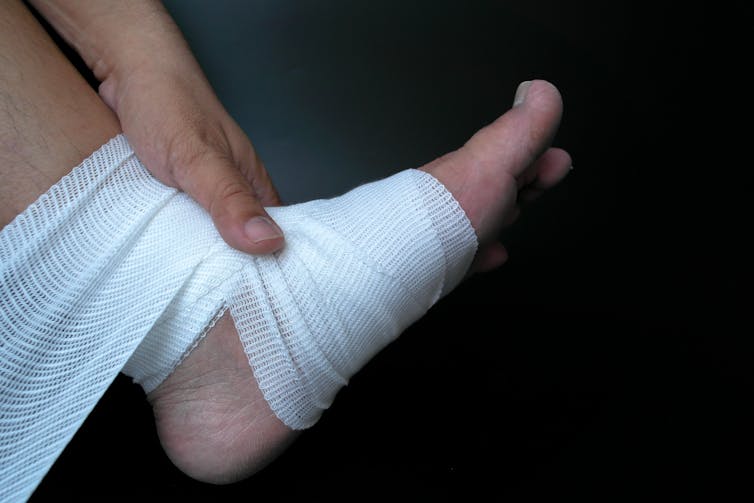Being active is beneficial for our bodies and mental health. But sometimes we can overdo it, resulting in sprains, strains, or pulled muscles. We need time to rehabilitate, or more injuries will occur.
If you’ve sustained an injury, the first thing to ask yourself is whether there was a specific incident or moment when something happened – if you felt a muscle pull or perhaps rolled over on your ankle. If there was, how severe was the load or force that resulted in the injury? What tissues were under stress – for example, was it a muscle, ligament, or bone? This will help you determine the severity of the injury. Common acute injuries include ankle sprains, hamstring muscle strains, and wrist fractures.
If there’s immediate swelling this is usually caused by internal bleeding, which means the injury is more serious and may need more immediate attention. However, most injuries take a few hours for swelling to develop, which is a type of inflammation that is a normal part of the healing process.
Inflammation is the body’s response to damage, injury, or disturbance to normal bodily function. The aim of inflammation is as a defence mechanism that protects from infection, stems the bleeding, and removes the injured tissues. There may also be some bruising visible after a few days. This doesn’t always appear over the injured area, as bleeding from the injury tracks down the limb.
You’re probably familiar with the acronyms, “RICE” and “PRICE”, which are often recommended for treating a sports injury. The main idea of both is to rest, ice the injured part, compress it, and elevate the injured area above your heart. Recently these protocols have been questioned, with new recommendations aimed at maximising the healing process. However, protection (reducing the risk of further injury), elevating, compression, and reducing load on the injured area are all still recommended.
Using ice during recovery is contested as some evidence suggests it has little effect on improving the speed of recovery or the outcome. So prioritising protection, compression, and elevation are important.
Read more… Three Things You Can Do To Decrease Inflammation That Causes and Advances Many Common Diseases
Early movement is also essential to ensure good blood supply to the area to help the healing process. However, some injuries are very painful, and this might indicate a longer rehabilitation process.
Acute severe pain can still be relieved with cold or ice. However, it’s now advised that people avoid taking anti-inflammatory medications (such as ibuprofen) for acute trauma injuries as we need the inflammation for the healing process.

The body is impressive, and most injuries or trauma heal themselves. However, this healing is fragile after the initial injury, so resting for the first few days will allow healing to begin. Loading the injured area, in a controlled manner, after 24 to 48 hours will increase tissue strength.
This could be starting with free active range of movement exercises, such as bending, straightening and rotating the joint for knee and ankle injuries. Then, progress to gentle resistance exercises, before moving on to functional loading exercises, such as walking, lifting, and carrying.
Managing minor trauma (such as strains or sprains), is easy. However, healing time depends on factors such as age, gender, and overall health.
Overuse injuries
If there was no specific incident that caused your injury, then it could be caused by overloading. Common overuse injuries include tennis elbow, shin splints, runner’s knee, and Achilles tendinitis. Overloading, or overuse, injuries happen when we increase our exercise load too quickly, or perform repetitive motions.
If we increase our exercise load gradually and allow our tissues to adapt, then they become stronger and able to adapt. For example, this might involve gradually progressing to lifting heavier weights at the gym as you become stronger.
However, if you overload by doing intense activities or performing high repetitions, this can cause tissue breakdown. Signs of this include blisters after a marathon, or “tennis elbow” after intense periods of gardening. It can be hard to know the causes of these types of injuries, as it may simply be caused by something that you’re repeatedly doing for long periods of time. Reducing or modifying this activity will help with healing.
Constant soreness or pain commonly occurs during the first few days as inflammation starts for acute injuries and overload problems. After a few days, this decreases. If you’re not aware of the soreness all the time, then moving the area is essential. Start with three to four range of motion exercises in all directions (such as bending and straightening the joint), repeating every three to four hours. Increase the number of movements and reduce the frequency as the days progress, until you’re using the injured area more normally during daily activities.
Problems can still happen though, especially if we rest, assume it’s healed, and return to doing the same amount of activity we did when the injury happened. It’s important to gradually increase activity to allow the body to adapt. Similarly if you are overloading, reduce the amount you’re doing and think about how you can modify the activity.
There’s always a cause for an injury, therefore try to assess the reason so you can reduce your risk of future injuries.
Following an injury from trauma, the area will be sore all the time for the first few days as the inflammatory process develops and your body starts to repair. But for both types of injuries, the best advice remains to rest only for 24 to 48 hours, then gradually work your way back to doing the amount of activity you were doing before your injury.
Sheila Leddington Wright, Principal Lecturer in Sports Therapy, Coventry University
This article is republished from The Conversation under a Creative Commons license. Read the original article.

